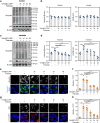Verapamil-loaded supramolecular hydrogel patch attenuates metabolic dysfunction-associated fatty liver disease via restoration of autophagic clearance of aggregated proteins and inhibition of NLRP3
- PMID: 36670488
- PMCID: PMC9854054
- DOI: 10.1186/s40824-023-00342-5
Verapamil-loaded supramolecular hydrogel patch attenuates metabolic dysfunction-associated fatty liver disease via restoration of autophagic clearance of aggregated proteins and inhibition of NLRP3
Abstract
Background: Obesity, a serious threat to public health, is linked to chronic metabolic complications including insulin resistance, type-2 diabetes, and metabolic dysfunction-associated fatty liver disease (MAFLD). Current obesity medications are challenged by poor effectiveness, poor patient compliance, and potential side effects. Verapamil is an inhibitor of L-type calcium channels, FDA-approved for the treatment of hypertension. We previously investigated the effect of verapamil on modulating autophagy to treat obesity-associated lipotoxicity. This study aims to develop a verapamil transdermal patch and to evaluate its anti-obesity effects.
Methods: Verapamil is loaded in biomimetic vascular bundle-like carboxymethyl pullulan-based supramolecular hydrogel patches cross-linked with citric acid and glycerol linkages (CLCMP). The investigation was then carried out to determine the therapeutic effect of verapamil-loaded CLCMP (Vera@CLCMP) on diet-induced obese mice.
Results: Vera@CLCMP hydrogel patches with hierarchically organized and anisotropic pore structures not only improved verapamil bioavailability without modifying its chemical structure but also enhanced verapamil release through the stratum corneum barrier. Vera@CLCMP patches exhibit low toxicity and high effectiveness at delivering verapamil into the systemic circulation through the dermis in a sustained manner. Specifically, transdermal administration of this patch into diet-induced obese mice drastically improved glucose tolerance and insulin sensitivity and alleviated metabolic derangements associated with MAFLD. Furthermore, we uncovered a distinct molecular mechanism underlying the anti-obesity effects associated with the hepatic NLR family pyrin domain-containing 3 (NLRP3) inflammasome and autophagic clearance by the vera@CLCMP hydrogel patches.
Conclusion: The current study provides promising drug delivery platforms for long-term family treatment of chronic diseases, including obesity and metabolic dysfunctions.
Keywords: Autophagic clearance; Carboxymethyl pullulan; Hydrogel; Inflammasome; Metabolic associated fatty liver disease; Transdermal delivery.
© 2023. The Author(s).
Conflict of interest statement
The authors declare that they have no competing interests.
Figures









Similar articles
-
Intravenous sustained-release nifedipine ameliorates nonalcoholic fatty liver disease by restoring autophagic clearance.Biomaterials. 2019 Mar;197:1-11. doi: 10.1016/j.biomaterials.2019.01.008. Epub 2019 Jan 7. Biomaterials. 2019. PMID: 30623792
-
Colchicine mesoporous silica nanoparticles/hydrogel composite loaded cotton patches as a new encapsulator system for transdermal osteoarthritis management.Int J Biol Macromol. 2020 Dec 1;164:1149-1163. doi: 10.1016/j.ijbiomac.2020.07.133. Epub 2020 Jul 18. Int J Biol Macromol. 2020. PMID: 32693125
-
Free fatty acids impair autophagic activity and activate nuclear factor kappa B signaling and NLR family pyrin domain containing 3 inflammasome in calf hepatocytes.J Dairy Sci. 2021 Nov;104(11):11973-11982. doi: 10.3168/jds.2021-20273. Epub 2021 Aug 26. J Dairy Sci. 2021. PMID: 34454753
-
Calcium channel blockers as potential therapeutics for obesity-associated autophagy defects and fatty liver pathologies.Autophagy. 2014;10(12):2385-6. doi: 10.4161/15548627.2014.984268. Autophagy. 2014. PMID: 25484079 Free PMC article. Review.
-
Fatty Acids and NLRP3 Inflammasome-Mediated Inflammation in Metabolic Tissues.Annu Rev Nutr. 2017 Aug 21;37:77-102. doi: 10.1146/annurev-nutr-071816-064836. Annu Rev Nutr. 2017. PMID: 28826373 Review.
Cited by
-
Exo-hydrogel therapy: a revolutionary approach to managing diabetic complications.J Nanobiotechnology. 2025 Aug 11;23(1):558. doi: 10.1186/s12951-025-03621-6. J Nanobiotechnology. 2025. PMID: 40790200 Free PMC article. Review.
-
Host-directed therapy for tuberculosis.Eur J Med Res. 2025 Apr 11;30(1):267. doi: 10.1186/s40001-025-02443-4. Eur J Med Res. 2025. PMID: 40211397 Free PMC article. Review.
-
Thioredoxin (Trx): A redox target and modulator of cellular senescence and aging-related diseases.Redox Biol. 2024 Apr;70:103032. doi: 10.1016/j.redox.2024.103032. Epub 2024 Jan 13. Redox Biol. 2024. PMID: 38232457 Free PMC article. Review.
-
Methylsulfonylmethane ameliorates metabolic-associated fatty liver disease by restoring autophagy flux via AMPK/mTOR/ULK1 signaling pathway.Front Pharmacol. 2023 Nov 30;14:1302227. doi: 10.3389/fphar.2023.1302227. eCollection 2023. Front Pharmacol. 2023. PMID: 38099147 Free PMC article.
References
-
- Eslam M, Newsome PN, Sarin SK, Anstee QM, Targher G, Romero-Gomez M, Zelber-Sagi S, Wai-Sun Wong V, Dufour JF, Schattenberg JM, et al. A new definition for metabolic dysfunction-associated fatty liver disease: an international expert consensus statement. J Hepatol. 2020;73:202–209. doi: 10.1016/j.jhep.2020.03.039. - DOI - PubMed
Grants and funding
LinkOut - more resources
Full Text Sources

